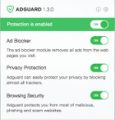What is FlexibleProtocol
According to security researchers, FlexibleProtocol is an adware program. Adware is a type of software whose motive is to generate money for its author. It have various ways of earning by showing the advertisements forcibly to its victims. Adware can generate pop-ups, display undesired advertisements, alter the victim’s browser settings, or redirect the victim’s internet browser to unrequested web-pages. Aside from causing unwanted ads and web browser redirects, it also can slow down the machine.
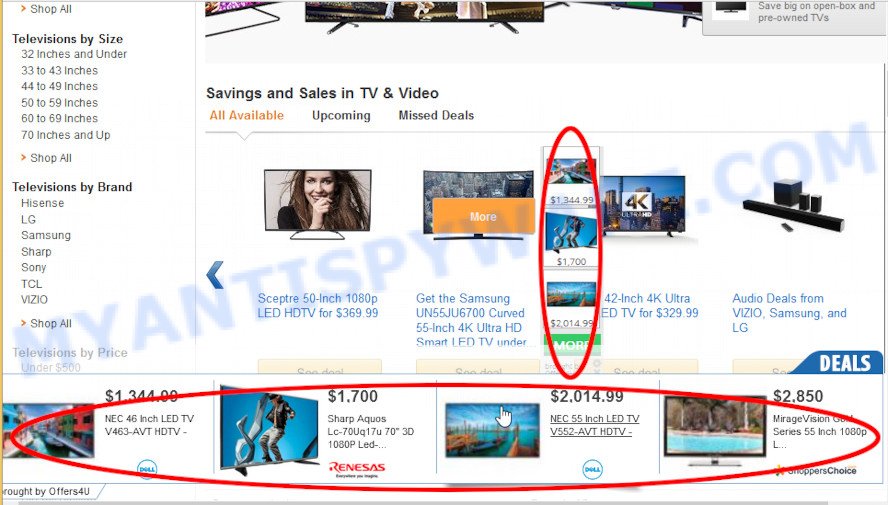
Unwanted ads
Another reason why you need to get rid of the FlexibleProtocol adware is its online data-tracking activity. It can be used to collect a wide variety of your personal data which can be later transferred to third parties. You don’t know if your home address, account names and passwords are safe.
If you would like to remove FlexibleProtocol and free your internet browser of unwanted advertisements and are unable to do so, you can use the guide below to detect and remove adware software and any other malware for free.
How does FlexibleProtocol get on your computer
Adware software usually spreads as a part of free applications that downloaded from the Internet. Which means that you need to be proactive and carefully read the Terms of use and the License agreement properly. For the most part, adware and potentially unwanted software will be clearly described, so take the time to carefully read all the information about the software that you downloaded and want to install on your Apple Mac.
Threat Summary
| Name | FlexibleProtocol, FlexibleProtocol 1.0 app |
| Type | adware software, potentially unwanted application (PUA), pop-ups, pop up virus, popup advertisements |
| Symptoms |
|
| Removal | FlexibleProtocol removal guide |
How to remove FlexibleProtocol
In most cases adware software requires more than a simple uninstall through the use of the Finder in order to be fully removed. For that reason, our team designed several removal methods that we have summarized in a detailed tutorial. Therefore, if you’ve the FlexibleProtocol adware on your MAC system and are currently trying to have it removed then feel free to follow the step-by-step guide below in order to resolve your problem. Read it once, after doing so, please bookmark this page (or open it on your smartphone) as you may need to shut down your web browser or reboot your MAC OS.
To remove FlexibleProtocol, execute the following steps:
- Remove unwanted profiles on Mac device
- Uninstall FlexibleProtocol associated software by using the Finder
- Remove FlexibleProtocol related files and folders
- Scan your Mac with MalwareBytes
- Remove FlexibleProtocol from Safari, Chrome, Firefox
- How to stay safe online
- To sum up
Remove unwanted profiles on Mac device
FlexibleProtocol can make changes to the Mac system such as malicious changes to browser settings, and the addition of malicious system profiles. You need to check the system preferences, find and remove malicious profiles and ensure your settings are as you expect.
Click Apple menu ( ![]() ) > System Preferences.
) > System Preferences.
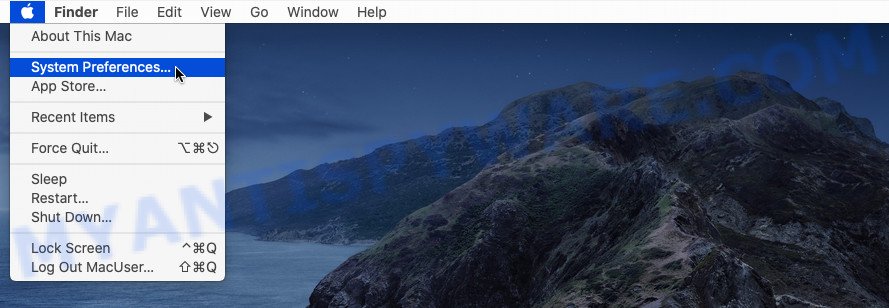
In System Preferences, select Profiles. if there is no Profiles in the list of preferences, that means there are no profiles installed on the Mac. If there is Profiles in the list, then click on it, then select a profile associated with FlexibleProtocol.
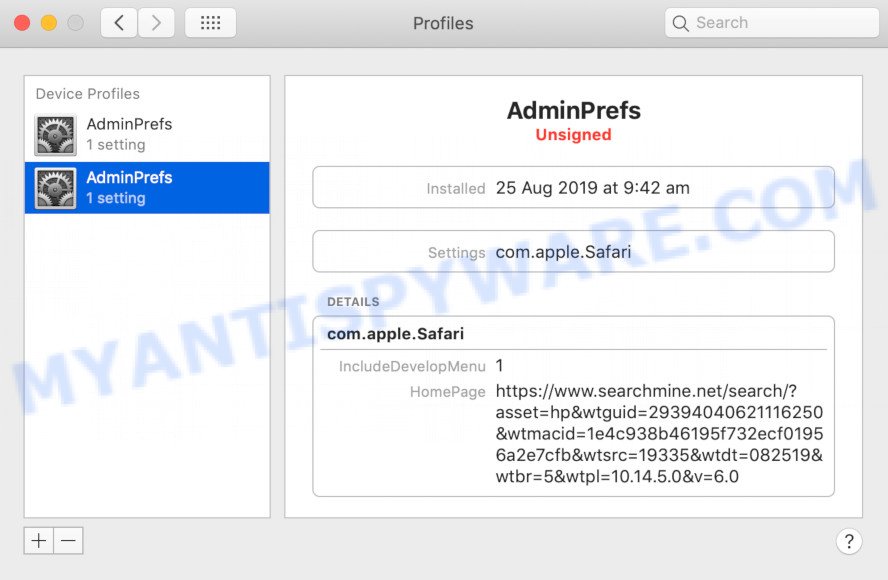
To delete a malicious profile, click on the minus button ( – ) located at the bottom-left of the Profiles screen.
Uninstall FlexibleProtocol associated software by using the Finder
It’s of primary importance to identify and remove adware software, browser hijackers and PUPs through ‘Applications’ section of your Finder.
Open Finder and click “Applications”.
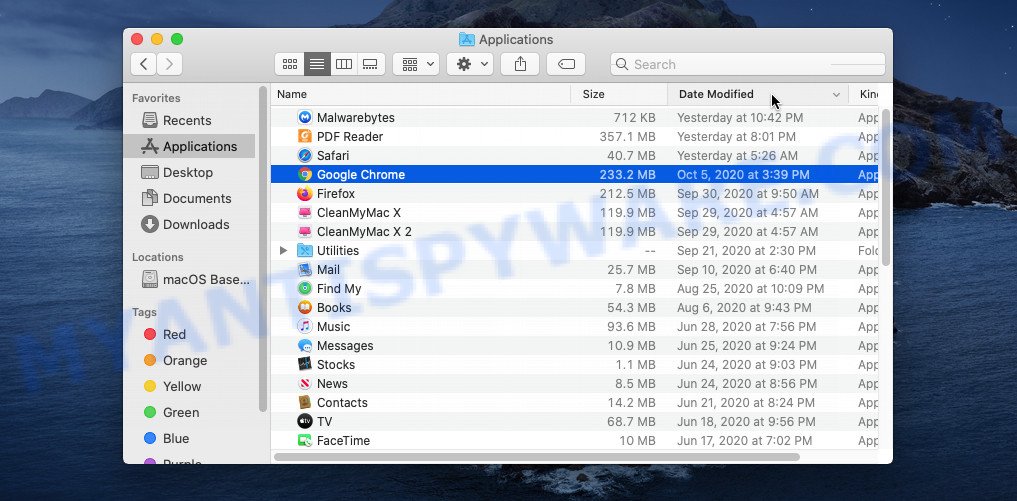
Carefully browse through the list of installed apps and get rid of all questionable and unknown applications.
After you have found anything dubious that may be the FlexibleProtocol or other PUP, then right click this application and choose “Move to Trash”. Once complete, Empty Trash.
Remove FlexibleProtocol related files and folders
Now you need to try to find FlexibleProtocol related files and folders, and then delete them manually. You need to look for these files in certain directories. To quickly open them, we recommend using the “Go to Folder…” command.
Click on the Finder icon. From the menu bar, select Go and click “Go to Folder…”. As a result, a small window opens that allows you to quickly open a specific directory.

Check for FlexibleProtocol generated files in the /Library/LaunchAgents folder

In the “Go to Folder…” window, type the following text and press Go:
/Library/LaunchAgents
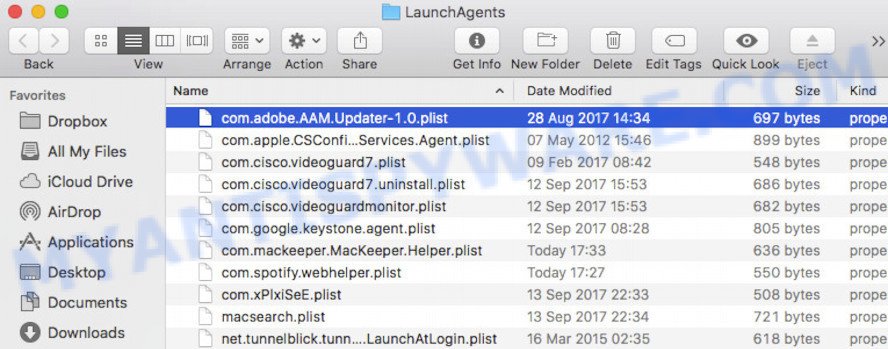
This will open the contents of the “/Library/LaunchAgents” folder. Look carefully at it and pay special attention to recently created files, as well as files that have a suspicious name. Move all suspicious files to the Trash. A few examples of files: search.plist, macsearch.plist, com.machelper.plist, installapp.plist and FlexibleProtocol.plist. Most often, browser hijackers, adware software and PUPs create several files with similar names.
Check for FlexibleProtocol generated files in the /Library/Application Support folder

In the “Go to Folder…” window, type the following text and press Go:
/Library/Application Support
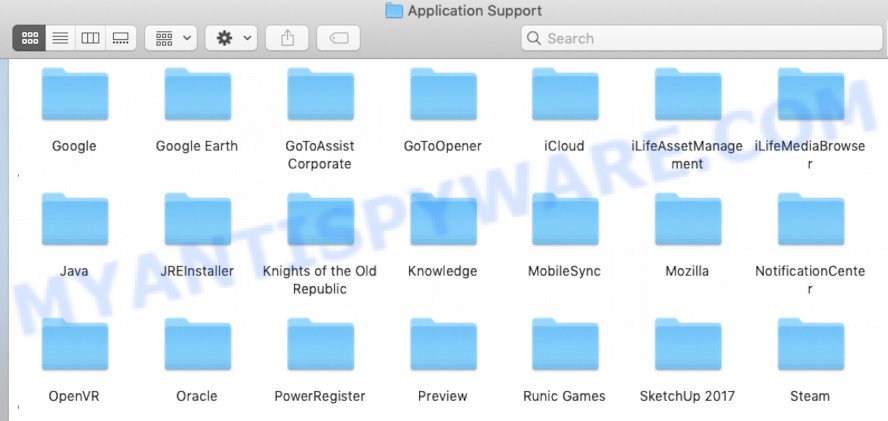
This will open the contents of the “Application Support” folder. Look carefully at its contents, pay special attention to recently added/changed folder. Move all suspicious folders to the Trash.
Check for FlexibleProtocol generated files in the “~/Library/LaunchAgents” folder

In the “Go to Folder…” window, type the following text and press Go:
~/Library/LaunchAgents

Proceed in the same way as with the “/Library/LaunchAgents” and “/Library/Application Support” folders. Look for suspicious and recently added files. Move all suspicious files to the Trash.
Check for FlexibleProtocol generated files in the /Library/LaunchDaemons folder
In the “Go to Folder…” window, type the following text and press Go:
/Library/LaunchDaemons

Carefully browse the entire list of files and pay special attention to recently created files, as well as files that have a suspicious name. Move all suspicious files to the Trash. A few examples of files to be deleted: com.installapp.plist, com.FlexibleProtocol.plist, com.macsearch.plist, com.search.plist and com.machelper.plist. In most cases, browser hijackers, adware and potentially unwanted programs create several files with similar names.
Scan your Mac with MalwareBytes
If you carefully followed the previous steps, then you should be able to remove FlexibleProtocol. Of course, very often browser hijackers, adware software and PUPs hides on a Mac, disguising itself as legitimate apps and files. Therefore, in some cases, it is difficult for an inexperienced user to decide whether a particular file is part of adware software, PUPs and browser hijackers. Therefore, we suggest you to use MalwareBytes Free to scan the Mac device.
Installing the MalwareBytes AntiMalware is simple. First you’ll need to download MalwareBytes Free by clicking on the following link.
21020 downloads
Author: Malwarebytes
Category: Security tools
Update: September 10, 2020
Once the downloading process is complete, close all apps and windows on your Apple Mac. Run the saved file. Follow the prompts.
The MalwareBytes Anti-Malware will automatically start and you can see its main screen such as the one below.
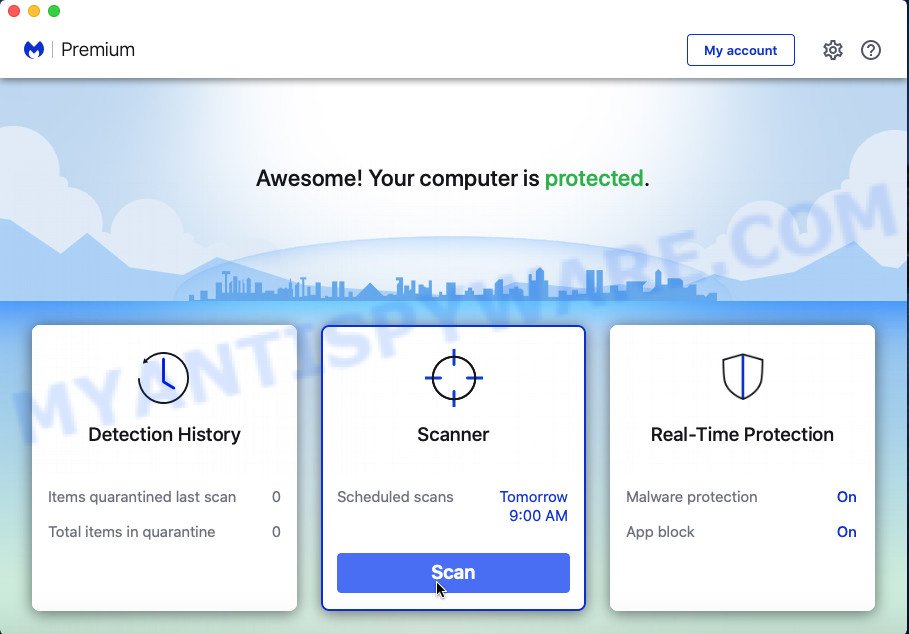
Now press the “Scan” button . MalwareBytes Anti Malware (MBAM) utility will begin scanning the whole computer to find out FlexibleProtocol adware. A system scan may take anywhere from 5 to 30 minutes, depending on your computer. While the MalwareBytes AntiMalware (MBAM) tool is checking, you can see how many objects it has identified as being infected by malware.
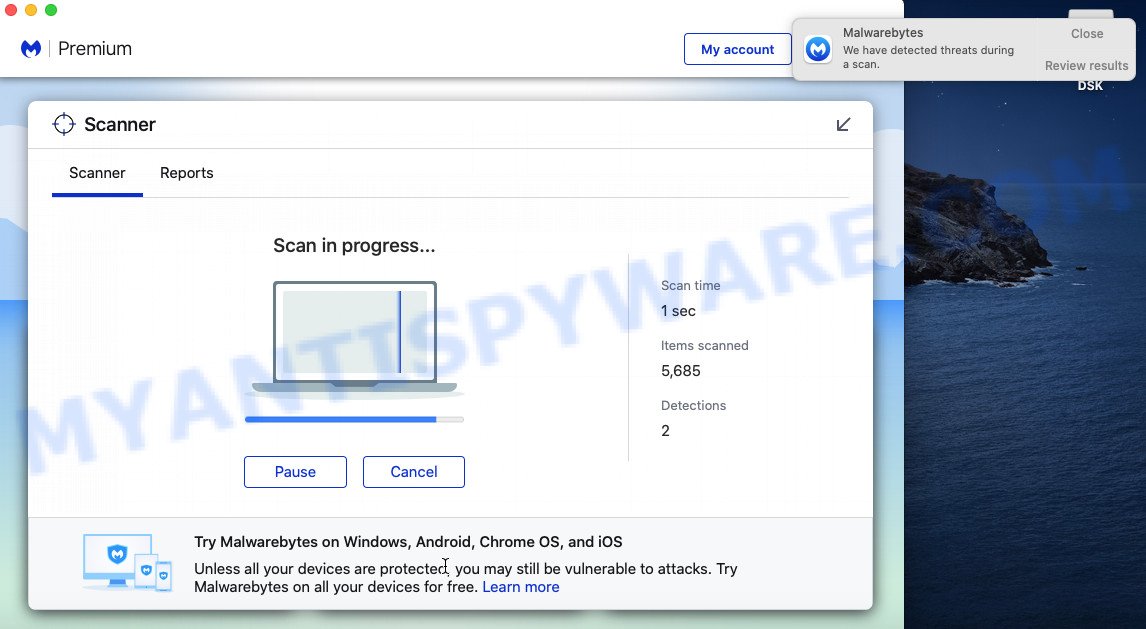
Once the scan get completed, MalwareBytes Free will display a scan report. Review the report and then click the “Quarantine” button. The MalwareBytes Anti Malware will delete FlexibleProtocol adware.
Remove FlexibleProtocol from Safari, Chrome, Firefox
If you are still getting FlexibleProtocol , then you can try to get rid of it by removing harmful extensions.
You can also try to get rid of FlexibleProtocol adware by reset Google Chrome settings. |
If you are still experiencing issues with FlexibleProtocol adware software removal, you need to reset Firefox browser. |
|
How to stay safe online
Using an ad-blocking application such as AdGuard is an effective way to alleviate the risks. Additionally, ad blocking programs will also protect you from malicious ads and webpages, and, of course, block redirection chain to misleading, scam and similar web pages.
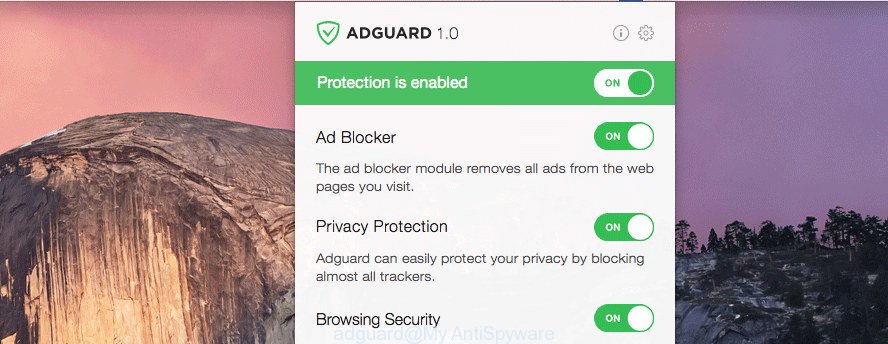
Download AdGuard on your MAC by clicking on the following link.
3780 downloads
Author: © Adguard
Category: Security tools
Update: January 17, 2018
Once downloading is complete, run the downloaded file. You will see the “Setup Wizard” screen. Follow the prompts.
Each time, when you start your MAC OS, AdGuard will start automatically and stop unwanted popups, block harmful and misleading web-pages.
To sum up
Now your MAC OS should be free of the FlexibleProtocol adware. We suggest that you keep MalwareBytes AntiMalware (to periodically scan your machine for new adware softwares and other malicious software) and AdGuard (to help you block unwanted pop ups and harmful web sites). Moreover, to prevent any adware, please stay clear of unknown and third party software.
If you need more help with FlexibleProtocol related issues, go to here.

